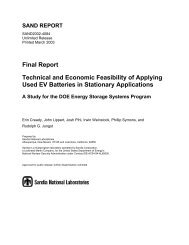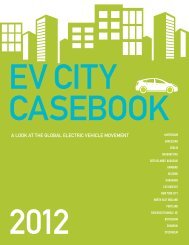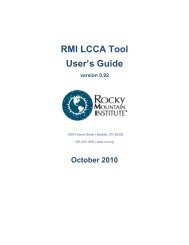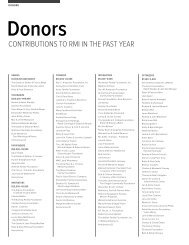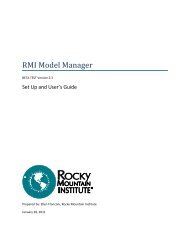Fleet Electrification Roadmap
Fleet Electrification Roadmap
Fleet Electrification Roadmap
- No tags were found...
Create successful ePaper yourself
Turn your PDF publications into a flip-book with our unique Google optimized e-Paper software.
14 executive summaryfleet electrification roadmap 15PART THREEIdentifying <strong>Fleet</strong> OpportunitiesIn order to better understand the business, economic,and cost-saving opportunities presented by electrificationof vehicle fleets, an economic model was developedfor the <strong>Fleet</strong> <strong>Electrification</strong> <strong>Roadmap</strong>. The modelcompares the total cost of ownership (TCO) of samplevehicles by vehicle weight class and industry segmentfor a given acquisition year. Technologies consideredwere ICE, HEV, PHEV-40, and EV-100. The analysisconsiders vehicle TCO in three cases: a base case, anoptimization case, and a combined optimization pluspolicy incentives case.Base Case: The base case assumes operators purchasevehicles being offered in the market today at current specifications.Operators make no behavioral changes to reducecost. Public policy is not considered in the base case.Operators do not benefit from existing or future subsidies.Optimized Case: The optimized case assumes fleet operatorscan purchase vehicles that fit their needs and thatthey will use them in the manner that most efficientlylowers cost. Battery right-sizing and extended ownershipperiods are examples of optimized use. Operators do notbenefit from existing or future subsidies.Policy Case: The policy case builds on the optimizationcase, adding existing federal government incentives forlight-duty vehicles and assuming additional subsidies notcurrently in law for medium- and heavy-duty trucks.The model analysis suggests that electric drive vehiclesare cost competitive in a number of fleet applicationstoday—even when assuming no access to governmentsubsidies and no change in purchasing or usage patterns.In fact, traditional hybrids are a cost-effective replacementfor internal combustion engine vehicles by 2012in most of the segments where driving distance exceeds20,000 miles per year. This is a result of the relativelysmall incremental investment for an HEV compared toan ICE vehicle. In the base case, GEVs begin to emerge asthe most cost effective solution between 2015 and 2018 asbattery costs begin to fall below $400/kWh.The cost effectiveness timeline for each of the electricdrive vehicle technologies is improved by optimizingoperations and vehicle characteristics for a number offleet applications. In particular, two options stand out:optimizing the GEV ownership duration to coincidewith the battery life; and right-sizing the EV batteriesto meet the needs of low mileage fleet applications.These two actions taken by fleet operators wouldadvance the time required for PHEVs and EVs to becomethe most cost effective solutions by approximately oneyear in a number of segments. Figure E6 presents thecompetitiveness timelines for the optimized case.Finally, when current and potential future governmentincentives are considered, the cross-over point forGEV cost parity is reached within the next two to threeyears in all of the commercial segments. The incentivesassumed for this analysis include $7,500 federal tax creditsapplied for GEV passenger car and class 1-2 trucks;$15,000 tax credits applied to class 3 medium-dutytrucks; $20,000 tax credits applies to class 4-5 mediumdutytrucks; and $25,000 tax credits applied to class 6-7heavy-duty trucks. (The full credits were assumed to beavailable through 2015, after which they were rampeddown annually, reaching zero in 2020.)In all cases, this analysis implies a progression incost competitiveness from ICE, though HEV, to PHEV-40 and EV-100. <strong>Fleet</strong> owner behavior and public policycan have a dramatic impact on the rate of that progression,but rising fuel costs coupled with falling electricdrive component costs suggest that PHEVs and EVswill increase in competitiveness over time in nearly allfleet segments.FIGURE E5Lowest TCO Drivetrain Technology by Year and Segment – BaseCLASSPassengerClass 1-2Class 3Class 4-5Class 6-7FIGURE E6Lowest TCO Drivetrain Technology by Year and Segment – Operations OptimizedCLASSPassengerClass 1-2Class 3Class 4-5Class 6-7FIGURE E7Lowest TCO Drivetrain Technology by Year and Segment — Operations Optimized + Government IncentivesCLASSPassengerClass 1-2Class 3Class 4-5Class 6-7129103A4A3B4B5678129103A4A3B4B5678129103A4A3B4B5678Source: PRTM analysisSEG. NAME MI/YR 2010 2011 2012 2013 2014 2015 2016 2017 2018 2019 2020 2020+Sales, Service, UtilityGovernmentTaxiRental / Car SharingSales, Service, Utility, Short HaulLight GovernmentSales, Service, Utility, Short HaulLight GovernmentMedium Short HaulMedium Utility, GovernmentHeavy Short HaulHeavy Utility, GovernmentSEG. NAME MI/YR 2010 2011 2012 2013 2014 2015 2016 2017 2018 2019 2020 2020+Sales, Service, UtilityGovernmentTaxiRental / Car SharingSales, Service, Utility, Short HaulLight GovernmentSales, Service, Utility, Short HaulLight GovernmentMedium Short HaulMedium Utility, GovernmentHeavy Short HaulHeavy Utility, GovernmentSEG. NAME MI/YR 2010 2011 2012 2013 2014 2015 2016 2017 2018 2019 2020 2020+Sales, Service, UtilityGovernmentTaxiRental / Car SharingSales, Service, Utility, Short HaulLight GovernmentSales, Service, Utility, Short HaulLight GovernmentMedium Short HaulMedium Utility, GovernmentHeavy Short HaulHeavy Utility, Government22K9K36K31K19K6K23K6K31K8K26K18K22K9K36K31K19K6K23K6K31K8K26K18K22K9K36K31K19K6K23K6K31K8K26K18KICE HEV PHEV 40 / EV 100ICE HEV PHEV 40 / EV 100ICE HEV PHEV 40 / EV 100



